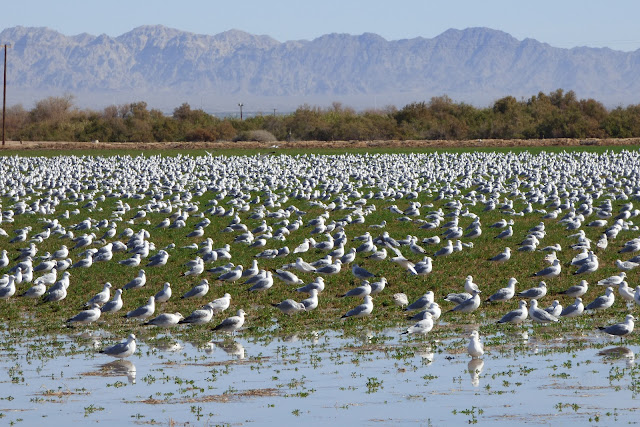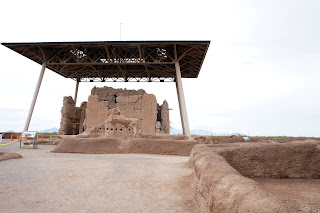More Photos
Introduction
On my road trips from Los Angeles to Tucson
usually I end up breaking the journey in Indio, CA, and visit spotlight
casino. After a meal and gambling 20 dollars away I hop onto I-10 and
drive into what seems like a never ending dessert. As I-10 climbs from
14 ft below sea level in Indio to 1700 feet at Chiriaco Summit it is
usual to get stuck behind a truck struggling to pass another truck with
blinkers on which in turn is struggling to climb the hill. Not sure if
it was loosing more money than usual in Spotlight Casino or the boredom
with the all too familiarity of the route that spurred me to take
highway 111 and take a break near the Salton Sea Visitor center which is
just a short distance from the town of Mecca.
The first thing I noticed after getting out of my car was the terrible stench and I have a very poor sense of smell. The ladies who pulled into the parking lot after me were surprised by the stench as well as evident by their comments. However, the vista of vast body of water, almost 340 square miles or so, in the middle of a dessert with a slim shore line, with Pelicans and hardly any people in sight was a reward in itself.
As I walked towards the shoreline the sand seemed very coarse and make a peculiar crunchy sound. A closer examination of the "sand" revealed I was actual stepping on the dried carcasses of the fish and the entire shoreline seemed like a open graveyard of fishes. Quite a few theories went through my mind none of which were even closer to the truth. Apparently millions of fish die every summer, mainly Tilapia, due to depletion of dissolved oxygen in these waters and gets washed ashore. The raise and fall Salton Sea seems to resemble the tragedy of these fishes.
few visitors which was a bit surprising to me but there are plenty of birds who flock together at whatever the feather composition maybe. And beware! There are no public bathrooms here either.
 After
feeling bit burnt after a visit to Leslies Canyon Wild Life Refuge when
I saw signs for this refuge I was bit tentative and was in no mood to
drive on a unpaved road again but decided to check this out anyway.
After driving for about five miles from Highway 111 turn off i was
rewarded with a field on the side of the road filled with snow geese and
a handful of birds whose name I have no idea of, some kind of crane I
imagine. They were pretty patient with me walking around at the edge
taking photos but very watchful. This encouraged me to continue on with
the exploration to the visitor center.
After
feeling bit burnt after a visit to Leslies Canyon Wild Life Refuge when
I saw signs for this refuge I was bit tentative and was in no mood to
drive on a unpaved road again but decided to check this out anyway.
After driving for about five miles from Highway 111 turn off i was
rewarded with a field on the side of the road filled with snow geese and
a handful of birds whose name I have no idea of, some kind of crane I
imagine. They were pretty patient with me walking around at the edge
taking photos but very watchful. This encouraged me to continue on with
the exploration to the visitor center.
The visitor center is small but adequate with
bathrooms and plenty of parking. There is a observation deck near the
visitor center, but there was not much to observe from that vantage
point. The bird viewing area is along the Rock hill trail, an easy one
mile trail (one way). It starts at the visitor center and ends on top
of Rock Hill. Rock hill is one of the 5 small lava domes in Salton sink
area, also known as Salton Buttes. Salton Buttes are the only active
volcanoes in Southern California. The last recorded volcanic activity
was around 900 B.C., way before the modern Salton sea was formed.
Just before the Rock hill there are few man-made islands meant as breeding grounds for some of these birds. Top of the hill offers the vista of entire salton sea and an encounter with visitors who were gracious enough to share their knowledge of the birds.
Unfortunately, there was not much to be seen from these observation deck either and there was not much human activity here. Probably because of the time of the day. One can see abundance and variety of birds in the neighboring fields. However, due to widespread nature of this area density of the bird population seemed bit sparse. The photo blind is located a short hike from the observation deck. There are different fields with different levels of water to accommodate
different species of wading birds. Around 2 PM when I was about to leave it was getting real toasty. Considering it was early Feb one can only imagine how brutal it could be few months from now. On my drive back I could see flocks of birds coming back and it probably is a great place to visit later in the afternoon.
The first thing I noticed after getting out of my car was the terrible stench and I have a very poor sense of smell. The ladies who pulled into the parking lot after me were surprised by the stench as well as evident by their comments. However, the vista of vast body of water, almost 340 square miles or so, in the middle of a dessert with a slim shore line, with Pelicans and hardly any people in sight was a reward in itself.
As I walked towards the shoreline the sand seemed very coarse and make a peculiar crunchy sound. A closer examination of the "sand" revealed I was actual stepping on the dried carcasses of the fish and the entire shoreline seemed like a open graveyard of fishes. Quite a few theories went through my mind none of which were even closer to the truth. Apparently millions of fish die every summer, mainly Tilapia, due to depletion of dissolved oxygen in these waters and gets washed ashore. The raise and fall Salton Sea seems to resemble the tragedy of these fishes.
SALTON SEA OVERVIEW
This seemingly desolate area sitting on top of San Andraes fault with intriguing names of surrounding towns like Macca, Bombay Beach etc has not only interesting geological history but also a unique history of human settlement and is a object of number of documentaries that can be found of youtube. Here are some interesting facts :- But for the delta created by Colorado river, salton sea would have been part of the ocean instead of being a lake. Some people in the neighboring town of Indio would have had ocean front properties.
- The max depth of salton sea is around 42 feet
- For the thousands of years before the taming of Colorado river this area has alternated between a fresh water lake, saline lake and a dry dessert depending on the moods of the Colorado river.
- Current formation of the Salton sea was due to a engineering accident while trying to increase the water flow into this area that caused constant flow of water for almost two years from Colorado river.
- This area was also used by military for various research projects (including atomic bomb research) before abandonment.
- 1950s and 1960s saw the peak visitor usage of Salton sea area rivaling that of Yosemite.
- 7.6 million fish deaths in a single day was recorded in August 1999
- Close to 9000 pelicans died of avian botulism in 1996 in this area.
BOMBAY BEACH
Some of the beaches here are fee areas but Bombay beach is free and is like open museum containing relics that symbolize raise and fall of salton sea as a recreational area. Although this whole area is full of abandoned houses there are some people who actually live here. The beach itself is full of relics from the past - abandoned boats, fallen apart pier and other structures that I have no idea about. This time I did not see any dead fishes but lots of birds and quite afew visitors which was a bit surprising to me but there are plenty of birds who flock together at whatever the feather composition maybe. And beware! There are no public bathrooms here either.
SONNY BONO WILDLIFE REFUGE
 After
feeling bit burnt after a visit to Leslies Canyon Wild Life Refuge when
I saw signs for this refuge I was bit tentative and was in no mood to
drive on a unpaved road again but decided to check this out anyway.
After driving for about five miles from Highway 111 turn off i was
rewarded with a field on the side of the road filled with snow geese and
a handful of birds whose name I have no idea of, some kind of crane I
imagine. They were pretty patient with me walking around at the edge
taking photos but very watchful. This encouraged me to continue on with
the exploration to the visitor center.
After
feeling bit burnt after a visit to Leslies Canyon Wild Life Refuge when
I saw signs for this refuge I was bit tentative and was in no mood to
drive on a unpaved road again but decided to check this out anyway.
After driving for about five miles from Highway 111 turn off i was
rewarded with a field on the side of the road filled with snow geese and
a handful of birds whose name I have no idea of, some kind of crane I
imagine. They were pretty patient with me walking around at the edge
taking photos but very watchful. This encouraged me to continue on with
the exploration to the visitor center.  |
| View from Rock Hill |
Just before the Rock hill there are few man-made islands meant as breeding grounds for some of these birds. Top of the hill offers the vista of entire salton sea and an encounter with visitors who were gracious enough to share their knowledge of the birds.
UNIT - 1
This is the habitat for thousands of migratory birds and is 14 miles away from the visitor center. It is also easily accessible from highway 78 which runs parallel to the west shore of salton sea. It has a couple of observation decks and a photo blind. Coming from El Centro, CA, it would have made more sense for me to have visited this area first if I had known about it and then proceed to the visitor center. It has couple of observation decks few hundred feet apart.Unfortunately, there was not much to be seen from these observation deck either and there was not much human activity here. Probably because of the time of the day. One can see abundance and variety of birds in the neighboring fields. However, due to widespread nature of this area density of the bird population seemed bit sparse. The photo blind is located a short hike from the observation deck. There are different fields with different levels of water to accommodate
different species of wading birds. Around 2 PM when I was about to leave it was getting real toasty. Considering it was early Feb one can only imagine how brutal it could be few months from now. On my drive back I could see flocks of birds coming back and it probably is a great place to visit later in the afternoon.
















